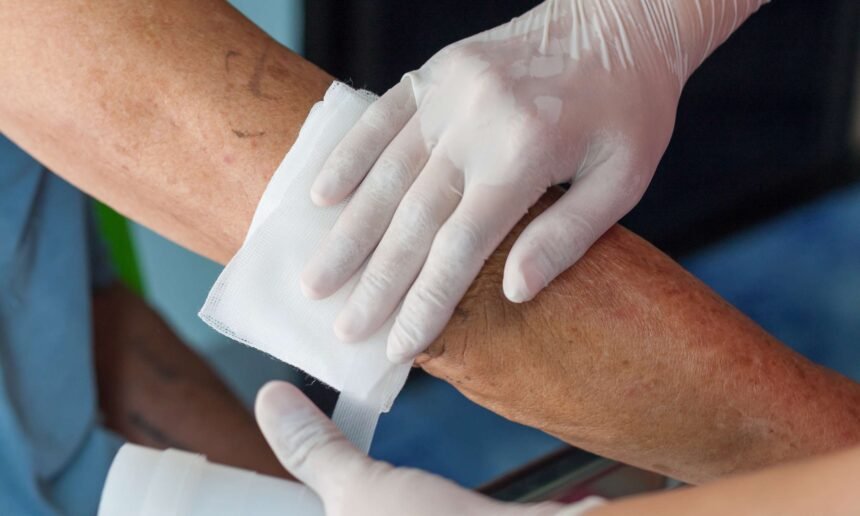Venous leg ulcers (VLUs) are chronic wounds that require consistent care to promote healing and prevent infections. These ulcers, caused by poor circulation due to venous insufficiency, can be painful and slow to heal. Proper daily wound care plays a crucial role in reducing complications and speeding up the healing process.
Learn what causes venous ulcers and how they’re diagnosed: What Are Venous Leg Ulcers? Causes, Symptoms & Treatment
Understanding Venous Leg Ulcers
Venous leg ulcers develop when blood fails to circulate properly in the lower legs, leading to increased pressure in the veins. This pressure damages the skin, causing open sores that are prone to infection. Without appropriate care, these wounds can worsen, leading to severe complications.
Common Symptoms of Venous Leg Ulcers
- Open sores on the lower leg or ankle
- Swelling and inflammation
- Pain and discomfort, especially when standing
- Hard, discolored skin around the wound
- Excessive wound drainage (exudate)
Risk Factors
- Chronic venous insufficiency
- Deep vein thrombosis (DVT)
- Obesity
- Smoking
- High blood pressure
- Diabetes
Essential Daily Care Tips for Venous Leg Ulcers
Proper daily ulcer care can prevent infections and promote healing. Here are some essential steps to follow:
1. Clean the Wound Properly
Cleaning the wound helps prevent bacterial infections and removes debris. Use mild saline solution or clean water to rinse the ulcer gently. Avoid harsh antiseptics, as they can delay healing.
Steps:
- Wash hands thoroughly before touching the wound.
- Use a sterile gauze pad to clean the area.
- Gently pat the wound dry with a clean towel.
2. Apply the Right Dressing
Selecting the appropriate wound dressing is essential for moisture balance and infection prevention. The dressing should be chosen based on the level of wound exudate.
Recommended dressings:
- Hydrocolloid dressings for moderate exudate
- Foam dressings for ulcers to absorb excess fluid
- Alginate wound care for high exudate levels
- Antimicrobial dressings if an infection is present
Need help choosing the best dressing for your wound? Explore: Best Wound Dressings for Venous Leg Ulcers
3. Use Compression Therapy
Compression therapy for leg ulcers is one of the most effective treatments for improving blood circulation and reducing swelling. This involves wearing compression bandages or compression stockings to support vein function.
Benefits:
- Reduces swelling and improves circulation
- Speeds up healing by reducing venous pressure
- Prevents ulcer recurrence
4. Elevate Your Legs Regularly
Elevating the legs helps improve blood flow and reduces pressure on the veins, preventing fluid buildup in the lower limbs.
How to do it:
- Keep legs elevated above heart level for 30 minutes, 3–4 times a day.
- Use pillows or an adjustable leg rest while sleeping.
5. Maintain Proper Hygiene
Keeping the affected leg clean and dry is essential in chronic wound care. Sweat, dirt, and bacteria can increase the risk of infection.
Tips:
- Change dressings as per medical guidance.
- Keep the surrounding skin moisturized to prevent dryness.
- Avoid using scented lotions or harsh soaps on the wound area.
6. Watch for Signs of Infection
Early detection of infections can prevent serious complications. Common signs of wound infection include:
- Increased redness and swelling
- Pus or foul-smelling discharge
- Persistent pain or warmth around the ulcer
- Fever or chills
If you notice any of these symptoms, seek medical attention immediately.
7. Follow a Healthy Diet
Proper nutrition supports the ulcer healing process. A balanced diet rich in vitamins and minerals can accelerate tissue repair.
Nutritional recommendations:
- Protein-rich foods (chicken, fish, eggs) for tissue repair
- Vitamin C sources (citrus fruits, bell peppers) for collagen formation
- Zinc-rich foods (nuts, seeds) for immune function
- Stay hydrated by drinking plenty of water
8. Avoid Smoking and Alcohol
Smoking and excessive alcohol consumption slow down wound healing by impairing circulation. Quitting smoking and reducing alcohol intake can significantly improve venous leg ulcer treatment outcomes.
9. Stay Active with Gentle Exercise
Light physical activity can improve circulation and prevent venous stasis, a major cause of leg ulcers.
Recommended exercises:
- Walking for 30 minutes daily
- Ankle flexing and leg stretches
- Yoga and low-impact aerobics
10. Schedule Regular Medical Checkups
Regular follow-ups with a healthcare provider ensure proper wound assessment and timely intervention in case of complications.


Leave a Reply